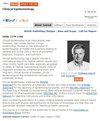药物诱发的妇科肿瘤:FDA 不良事件报告系统数据库的数据挖掘和分析
IF 3.2
2区 医学
Q1 PUBLIC, ENVIRONMENTAL & OCCUPATIONAL HEALTH
引用次数: 0
摘要
目的:药物引起的妇科炎症严重影响患者的健康和生活质量。本研究旨在对 FAERS 数据库中的妇科炎症报告和最常见的相关药物进行探索性分析:对 2004 年 1 月至 2023 年 12 月的 FAERS 进行了全面分析。利用报告的几率比(ROR)进行了比例失调分析和随后的敏感性分析,以确定可能与妇科乳腺增生有关的药物。采用逻辑回归分析评估潜在的风险因素。采用Weibull形状参数(WSP)检验来评估与妇科乳腺增生相关的主要药物的发病时间特征:研究发现了30265例妇科乳腺增生病例,其中85.50%的病例主要与神经系统药物有关。值得注意的是,利培酮占总病例数的 80.81%。在妇科肿瘤病例数≥5 例的 165 种药物中,利培酮(ROR 602.38,95% CI 585.07-620.20)、度他雄胺(ROR 17.18,95% CI 15.55-18.89)、螺内酯(ROR 15.8,95% CI 13.99-17.83)和帕利培酮(ROR 7.16,95% CI 6.55-7.84)的信号最强。在比例失调的敏感性分析中,观察到了意想不到的关联,如孟鲁司特(n = 21,ROR 1.94,95% CI 1.26-2.98)。逻辑回归分析表明,利培酮诱发妇科肿瘤的风险在成人患者中显著低于儿童患者(OR 0.12,95% CI 0.09-0.15),在体重较高的患者中显著低于体重较低的患者(OR 5.24,95% CI 3.62-7.76)。WSP测试表明,在前10种常见药物中,大多数药物诱发的妇科炎症往往发生在早期失效模式:结论:从 FAERS 中提取了与妇科乳腺增生有关的药物的排名和信号强度。结论:从 FAERS 中提取了与妇科肿瘤相关药物的排名和信号强度,研究了与妇科肿瘤相关的前 10 种药物的年龄分布和发病时间分布,有助于临床准确识别药物诱发的妇科肿瘤。本文章由计算机程序翻译,如有差异,请以英文原文为准。
Drug-Induced Gynecomastia: Data Mining and Analysis of the FDA Adverse Event Reporting System Database
Purpose: Drug-induced gynecomastia significantly affects patient health and quality of life. This study aimed to perform an exploratory analysis of gynecomastia reports and the most commonly associated medications within the FAERS database.
Patients and Methods: A comprehensive analysis of the FAERS from January 2004 to December 2023 was conducted. Disproportionality analysis and subsequent sensitivity analysis were performed to identify drugs potentially associated with gynecomastia, utilizing the reported odds ratio (ROR). Logistic regression analysis was employed to assess potential risk factors. The Weibull shape parameter (WSP) test was used to assess the time-to-onset characteristics of the top drugs associated with gynecomastia.
Results: The study identified 30,265 cases of gynecomastia, primarily associated with nervous system drugs, accounting for 85.50% of cases. Notably, risperidone accounted for 80.81% of the total cases. Among the 165 agents with ≥ 5 cases of gynecomastia, the strongest signals were exhibited by risperidone (ROR 602.38, 95% CI 585.07– 620.20), dutasteride (ROR 17.18, 95% CI 15.55– 18.89), spironolactone (ROR 15.8, 95% CI 13.99– 17.83), and paliperidone (ROR 7.16, 95% CI 6.55– 7.84). In the sensitivity analysis of disproportionality, unexpected associations were observed, such as montelukast (n = 21, ROR 1.94, 95% CI 1.26– 2.98). The logistic regression analysis indicated that the risk of risperidone-induced gynecomastia was significantly lower in adults compared to pediatric patients (OR 0.12, 95% CI 0.09– 0.15) and in patients with higher body weight than in those with lower body weight (OR 5.24, 95% CI 3.62– 7.76). The WSP test showed that gynecomastia induced by most of the top 10 common agents tends to occur in an early failure mode.
Conclusion: The rankings and signal strengths of drugs associated with gynecomastia were extracted from the FAERS. The age distribution and time-to-onset distribution of the top 10 drugs linked to gynecomastia were investigated, which can facilitate accurate clinical recognition of drug-induced gynecomastia.
Keywords: drug-induced, gynecomastia, FAERS, risperidone, time-to-onset
Patients and Methods: A comprehensive analysis of the FAERS from January 2004 to December 2023 was conducted. Disproportionality analysis and subsequent sensitivity analysis were performed to identify drugs potentially associated with gynecomastia, utilizing the reported odds ratio (ROR). Logistic regression analysis was employed to assess potential risk factors. The Weibull shape parameter (WSP) test was used to assess the time-to-onset characteristics of the top drugs associated with gynecomastia.
Results: The study identified 30,265 cases of gynecomastia, primarily associated with nervous system drugs, accounting for 85.50% of cases. Notably, risperidone accounted for 80.81% of the total cases. Among the 165 agents with ≥ 5 cases of gynecomastia, the strongest signals were exhibited by risperidone (ROR 602.38, 95% CI 585.07– 620.20), dutasteride (ROR 17.18, 95% CI 15.55– 18.89), spironolactone (ROR 15.8, 95% CI 13.99– 17.83), and paliperidone (ROR 7.16, 95% CI 6.55– 7.84). In the sensitivity analysis of disproportionality, unexpected associations were observed, such as montelukast (n = 21, ROR 1.94, 95% CI 1.26– 2.98). The logistic regression analysis indicated that the risk of risperidone-induced gynecomastia was significantly lower in adults compared to pediatric patients (OR 0.12, 95% CI 0.09– 0.15) and in patients with higher body weight than in those with lower body weight (OR 5.24, 95% CI 3.62– 7.76). The WSP test showed that gynecomastia induced by most of the top 10 common agents tends to occur in an early failure mode.
Conclusion: The rankings and signal strengths of drugs associated with gynecomastia were extracted from the FAERS. The age distribution and time-to-onset distribution of the top 10 drugs linked to gynecomastia were investigated, which can facilitate accurate clinical recognition of drug-induced gynecomastia.
Keywords: drug-induced, gynecomastia, FAERS, risperidone, time-to-onset
求助全文
通过发布文献求助,成功后即可免费获取论文全文。
去求助
来源期刊

Clinical Epidemiology
Medicine-Epidemiology
CiteScore
6.30
自引率
5.10%
发文量
169
审稿时长
16 weeks
期刊介绍:
Clinical Epidemiology is an international, peer reviewed, open access journal. Clinical Epidemiology focuses on the application of epidemiological principles and questions relating to patients and clinical care in terms of prevention, diagnosis, prognosis, and treatment.
Clinical Epidemiology welcomes papers covering these topics in form of original research and systematic reviews.
Clinical Epidemiology has a special interest in international electronic medical patient records and other routine health care data, especially as applied to safety of medical interventions, clinical utility of diagnostic procedures, understanding short- and long-term clinical course of diseases, clinical epidemiological and biostatistical methods, and systematic reviews.
When considering submission of a paper utilizing publicly-available data, authors should ensure that such studies add significantly to the body of knowledge and that they use appropriate validated methods for identifying health outcomes.
The journal has launched special series describing existing data sources for clinical epidemiology, international health care systems and validation studies of algorithms based on databases and registries.
 求助内容:
求助内容: 应助结果提醒方式:
应助结果提醒方式:


